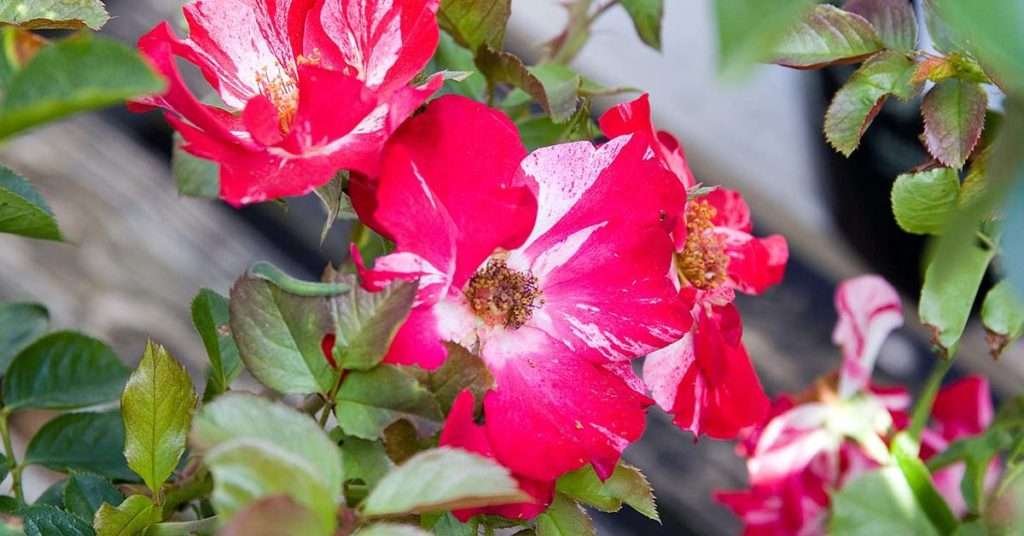Cabbage Roses

Via ItalianFoodForever.com
The Cabbage Rose, or Rosa Centifolia, is a commonly selected alternative to the typical wedding rose Floribunda, the “Iceberg Rose” as it is often termed.
Also known as the Provence Rose and Rose de Mai, the Cabbage Rose holds Dutch origins being first grown in the seventeenth century.
These shrubby, round roses are most often found in shades of pink, although white to dark red-purple Cabbage Roses are also less commonly found.
The name “Rosa Centifolia” means “the hundred petal rose” and this variety is marked by the distinctive, diverse, and, complex arrangements of petals found in the bloom of each cultivar, large or small.
Cultivars (Cultivated Varieties)
Lettuce Rose
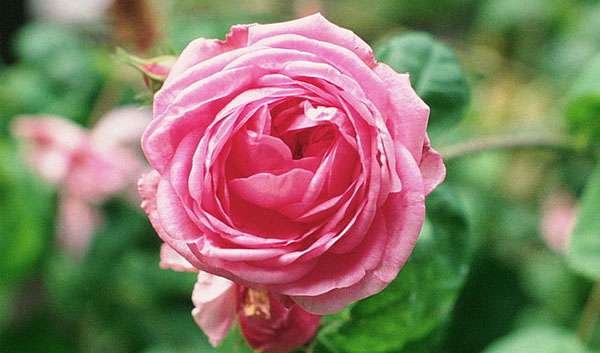
“As an Amazon Associate, I earn from qualifying purchases.”
Discovered in France in 1801 these historic roses are also known as Bullata Roses, or À Feuilles de Laitue.
The petals are arranged in such a fashion that they closely resemble the form of lettuce.
Bright yet pastel pink radiates from the outside, growing darker towards the center. They grow to roughly 5 to 6-inches and have a full flower with a high petal count.
These roses are quite hardy and persist without trouble throughout winter and cold weather.
Crested Moss Rose

Photo Credit: @exquisitelapel
The Crested Moss Rose, otherwise known as Cheapeau de Napoleon, or Rosa Centifolia Cristata, blooms with a pure, deep, and exceptionally pink color.
The shrub grows to about five feet tall and is rather sparse on foliage, unlike most other common varieties of roses.
The sepals have an uncanny resemblance to that of the parsley plant, making for a novel and attractive “moss-covered” stem.
The fragrance however is one of the most distinctive scents found, carrying a bold, spicy, damask scent that lingers.
You will find yourself smelling like roses every time you handle those of the Crested Moss variety.
Little Holland Rose

Little Holland Roses, also known as Petite de Hollande and Pompon des Dames, are perfectly suited to the small garden.
These medium to dark pink roses bloom in a clustered manner, two at a time.
The shrub grows to a height of roughly 50-inches and takes up just under 40-inches of space in your garden bed.
It is very compact and the bushy clusters of double blooms make for a beautiful arrangement.
These miniature roses carry a sweet, strong scent and although the petal structure is scattered, the deep centered Petite de Hollande is a highly attractive cultivar of the Cabbage Rose.
Rosa de Meaux Rose
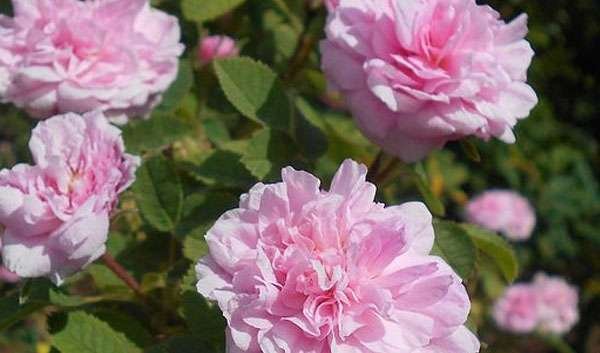
The button shaped bloom of Rosa de Meaux can be found in shades of mid-intensity pink and less commonly, snow white.
The shrub grows to approximately two-foot high by two feet wide and the foliage is dense and abundant.
Rosa de Meaux carries a subtle, sweet smell and the stem of this plant is rigid and firm.
The roses bloom in pairs creating bursts of color set upon the deep greenery of the foliage of this rose, a truly novel and beautiful sight to behold.
White Provence Rose

The hardy White Provence Rose is also known as Unique Blance, Mutabilis, Vièrge de Cléry, and Rosa Centifolia Alba, amongst its many names.
This is one of the most popular Cabbage Rose cultivars, carrying many uniquely attractive characteristics.
This rose has a very large, full double bloom that is found in pure white, near-white, and blends of off-shades to white.
The bloom has a silky texture and it is very bushy, carrying dark green foliage. The shrub grows to roughly five-foot high and takes about four feet of space in your garden bed.
Although the scent is very rose, carrying the distinctive damask scent to be expected, these roses are not very attractive to bees and other wildlife.
Village Maid Rose

The Village Maid Rose is also known as Centifolia Variegata, Gallica, Unique Panchee, and the Cottage Maid Rose.
It is an arching shrub that grows to a height of 6-foot, taking up roughly 4-foot of space in your garden.
The double blooms are striped, carrying a mix of creamy white striping the light, subtle pink, and apple-blossom pink predominant coloring.
Each of the cupped double blooms is roughly 2-inches in diameter and once-blooming many elegant, large, cupped flowers bring color to the dark green matte formed by the foliage.
Cabbage Rose Characteristics
The Cabbage Rose is a deciduous, perennial shrub (it only flowers once) that blooms in Spring and Summer, with seeds ripening come, Autumn.
The flowers are hermaphrodites, the Rosa Centifolia plant carries both staminate (male) pollen producing flowers, as well as carpellate (female) ovule-producing flowers.
Self-fertilized but pollinated by insects, Rosa Centifolia is a hardy shrub, with all cultivars resisting cold weather extremely well. Most are also extremely resistant to disease.
Full, fragrant blooms are ever-present, with certain cultivars carrying spicy, musky undertones.
Growing Cabbage Roses
Soil Requirements
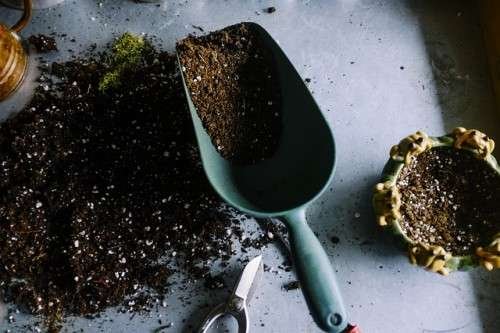
The Cabbage Rose grows optimally in rich soil that has a high composition of loam and Pete moss.
Your soil must feature good drainage, leaving no chance of puddles forming around the roots.
If good drainage is not facilitated your roses run the risk of developing a fungal infection that is near-impossible to get rid of.
Clay soil is also a good growing medium. The soil should be fairly acidic, with P.H. levels measuring between 6 and 6.5.
Propagation from Seed
Cabbage Roses can take up to two years to germinate from seed, making them a project that you will only reap the reward of in roughly three years.
One measure that can be employed to hasten this process is to scarify the seed, basically breaking down the seed wall to assist germination.
There are many ways to do this but it is typically easiest to scratch the seeds lightly with a light file or sandpaper.
The scratched seed wall will be thin enough to then plant into peat moss for two to three weeks at between 80 and 90 degrees Fahrenheit.
The soon to germinate seeds must then be placed in a cold area, keeping the temperature at no more than 40 degrees Fahrenheit for four months.
Only then will your seeds typically germinate.
Plants that are germinated indoors often suffer when subjected to the outdoors, battling under the change of environment and battering from the sun, wind, rain, and organisms in the new area of planting.
Although extra attention should be given to the transplanted plant, unless you are willing to wait out a duration of up to two years, then it would be best to use the controlled germination process given above.
Seedlings should be transplanted when reaching a height of roughly 10-inches.
When planting outdoors try to ensure a spacing of 3.96-feet between seeds.
This will ensure that the foliage will overlap, forming a dense, pleasing area of shrubbery.
Sow your seeds at a depth of 0.25-inches for optimal growth.
Propagation From Rose Cuttings
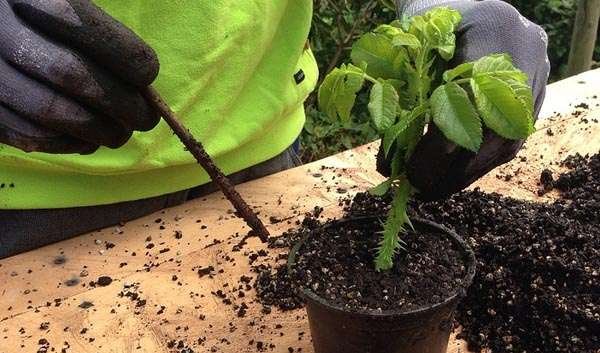
Cuttings can be taken as either soft-wood or hard-wood cuttings, but soft-wood cuttings root the easiest.
Although they are more delicate and fragile by nature, you will be able to propagate from soft-wood cuttings the easiest.
It is best to take a cutting about six weeks before your shrub begins to form leaves.
Propagation from hard-wood cuttings in the fall is not impossible, it is just a longer and more difficult process.
To take a cutting select any branch that you wish, and cut the end of the branch off. Each cutting should be roughly 5-inches long, be sure to take multiple cuttings to ensure success.
The cut that you made to remove the cutting itself is enough to make the plant develop roots.
It is also possible to “scar” the plant to assist rooting, to do so simply scrape the bark or outer-located tissue off half of the base of the cutting, to a length of approximately ½-inch.
If you chose to scar the base, then apply the rooting compound or some honey there, otherwise, just apply the honey or rooting compound to the cut that you made initially and place the cutting into your choice of growing medium.
Peat moss works very well. Water your cuttings well and if possible protect with a cloche, and you will be rewarded with a rooted Cabbage Rose in roughly one year.
Planting Bare-Root Roses
When you receive a Cabbage Rose complete with its root it is best to soak the root for twenty-four hours in distilled water.
- Immortal Love in a Box: Give your significant other a representation of your love; vibrant, lasting and beautiful. There is no better way to express your love than a bouquet of roses that lasts forever!
- Long-Lasting Roses: Made of premium fresh rose with a unique preservation process, our forever roses box lasts for 1 to 3 years. It has a total of 16 roses that are carefully and manually assembled for a personal touch.
- Available in Various Colors: Choose our preserved flowers bouquet in hues like red, white, purple, yellow, blue, velvet pink and pink. A gift that is tailored to your loved one's favorite color.
- Elegant Display Box: Housed in a durable black heart-shaped box, our bouquet make a great valentine decor. Keep it at room temperature without water and direct sunlight exposure to maintain the quality.
- Great Gift Idea: Make the most out of any celebration with our preserved roses in a box! Click 'Add to Cart' now and make it a great Valentine's gift for her, mom, birthday and more.
Transplanting once soaked is best done early in the morning, just before sunrise, during a new or waxing moon.
Be sure to plant in an area that has good drainage, full sun, and if possible, mulch the base of your Cabbage Rose.
Growth Environment
Cabbage Roses require full exposure to the sun, receiving a minimum of six hours of sunlight a day.
Seedlings should not be directly exposed to the sun and should instead be protected by cloches.
Cabbage Roses can be quite expansive and for this reason, it is best to grow them supported by a trellis, assisting your control of the plant. The base of your roses should always be well mulched.
Use a bark mulch or aged manure to bolster growth and absorb moisture.
Pruning
All roses, especially Cabbage Roses, need to be pruned and shaped to facilitate the biggest blooms.

It is best practice to leave one or two buds to a stem, this resulting in much larger blossoms.
Dead or diseased stems should always be removed from the plant as they are noticed.
Remove any stems that are growing towards the center of your rose bush. By shaping your rose bush towards an urn shape with an open center, you will ensure the best air circulation whilst making certain that new shoots do not get damaged by rubbing against others.
All stems should be shortened to roughly half their original length before the plant starts budding.
Companion Planting
Plant parsley beneath your Cabbage Roses to ensure healthy, magnificent roses with big blooms.
The root structure of the parsley plant helps for drainage in the soil, both parsley and roses require frequent watering, good nutrients, and full sun.
Plant garlic nearby to your Cabbage Roses to protect your plant against disease and to deter attack by insects.

Chives and onions planted nearby have the same effect, all of which prevent black spots from arising.
Lavender and catnip are especially useful for keeping rabbits away from your garden and roses.
Medicinal Uses
The root of the Cabbage Rose can be boiled and the water is used as a mild astringent.

The water resultant from boiling the roots is very refreshing to the skin and can be used to treat mild abrasions and irritations, moisturizing and healing your skin.
The petals of the Cabbage Rose have a mild laxative effect and are often also brewed to a tea that is used to treat mild constipation in infants.
As an essential oil, the extract of the Cabbage Rose is extremely high in vitamin A, C, and E. It is used primarily as a cleansing agent for exterior use on the skin.
What Does A Cabbage Rose Look Like?
Called a Provence rose but I think its nickname suits it best Cabbage Rose. Due to the fact that the petals are thickly stuffed like the leaves of a cabbage. … Cabbage roses can be found in a variety of colors which can include red, purple, white, and lavender. This plant does best in 4-9 on the U.S. Division of Agriculture zones.
Where Can I Buy Cabbage Roses?
Honestly, there aren’t many places online to purchase cabbage roses. The ones we did find have prices ranging from $9-$50 for a 5 gallon rose. Always purchase from a reputable seller.
Can You Eat Cabbage Roses?
The root of the Cabbage Rose can be boiled and the water is used as a mild astringent. The petals of the Cabbage Rose have a mild laxative effect and are often also brewed to a tea that is used to treat mild constipation in infants.
Are Cabbage Roses And Peonies The Same?
The two have a strong fragrance and pretty big blooms. Be that as it may if you take a look at the petals on the cabbage rose you will see they nearly whirl in the center and the bloom looks much more like a cabbage. Hence how it got its nickname the cabbage rose.
Watch The Video






